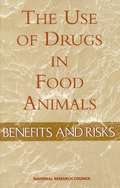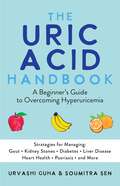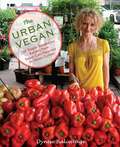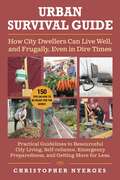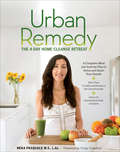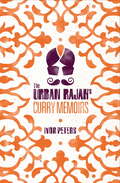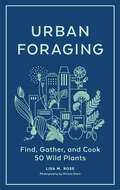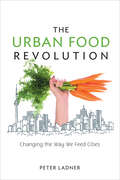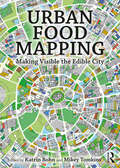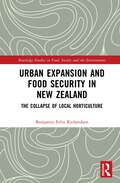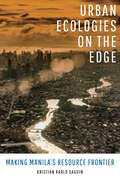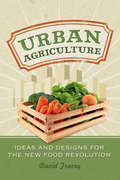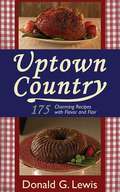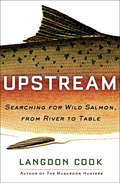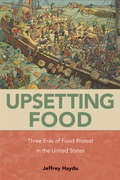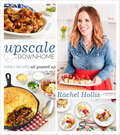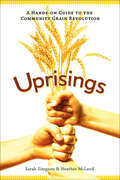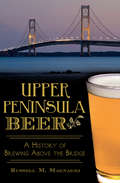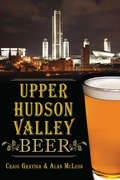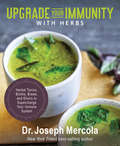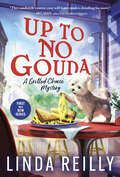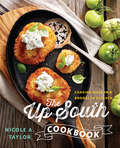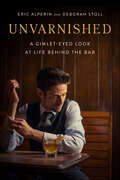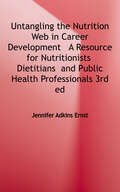- Table View
- List View
The Use Of Drugs In Food Animals: Benefits And Risks
by National Research CouncilThe use of drugs in food animal production has resulted in benefits throughout the food industry; however, their use has also raised public health safety concerns.The Use of Drugs in Food Animals provides an overview of why and how drugs are used in the major food-producing animal industries--poultry, dairy, beef, swine, and aquaculture. The volume discusses the prevalence of human pathogens in foods of animal origin. It also addresses the transfer of resistance in animal microbes to human pathogens and the resulting risk of human disease.The committee offers analysis and insight into these areas Monitoring of drug residues. The book provides a brief overview of how the FDA and USDA monitor drug residues in foods of animal origin and describes quality assurance programs initiated by the poultry, dairy, beef, and swine industries.Antibiotic resistance. The committee reports what is known about this controversial problem and its potential effect on human health. The volume also looks at how drug use may be minimized with new approaches in genetics, nutrition, and animal management. November
The Uric Acid Handbook: A Beginner's Guide to Overcoming Hyperuricemia (Strategies for Managing: Gout, Kidney Stones, Diabetes, Liver Disease, Heart Health, Psoriasis, and More)
by Urvashi GuhaTake control of your health with this easy-to-use guide to lowering uric acid levels and managing gout, liver disease, heart health, and more!Millions of Americans experience high uric acid levels, aka hyperuricemia, and as a result suffer from health conditions like gout, liver disease, kidney stones, heart disease and more. Uric acid is a waste product found in the blood. The body naturally dissolves uric acid, but sometimes it can build up in the body and cause major health problems. With The Uric Acid Handbook, you will first learn what uric acid is and how it operates within your body. Then this book will walk you through how you may be unknowingly increasing your uric acid levels and the certain health risks associated with doing so. Using relatable anecdotes and research-backed strategies, this friendly guide will give you all the tools you need to lower your uric acid levels, including: Professional advice from health-care providers Recipes and recommended foods that are low in uric acid Simple strategies for making daily lifestyle changes And more! The Uric Acid Handbook is the ultimate fact-filled guide to managing your hyperuricemia or simply improving your overall health.
The Urban Vegan: 250 Simple, Sumptuous Recipes from Street Cart Favorites to Haute Cuisine
by Dynise Balcavage<p>Transforming vegan cooking from "oat cuisine" to "haute cuisine" <p>Sampling ruby-red organic berries at a farmers' market. Comparing thirty varieties of rice noodles in a Vietnamese food store. Ordering “good & greasy” vegetarian rotis from a street cart. This is the life of the urban vegan, and author Dynise Balcavage brings this cuisine to life in The Urban Vegan. Designed to help vegans―and all readers―find inspiration for a healthy, varied, and delicious diet in each city market, restaurant, and corner store that they visit, this book presents 250 delicious, and even decadent, original vegan recipes inspired by the colorful culinary landscapes of urban areas. <p>Accompanying the recipes are shortcuts, entertaining ideas, and menu themes that will please even omnivores; an overview of the vegan pantry; and helpful icons that alert readers to low-fat, kid-friendly, fast, omnivore-friendly, and frugal recipes at a glance.</p>
Urban Survival Guide: How City Dwellers Can Live Well, and Frugally, Even in Dire Times
by Christopher NyergesPractical Guidelines to Resourceful City Living, Self-reliance, Emergency Preparedness, and Getting More for Less A survival guidebook that reflects the world in which we now find ourselves. The post 9/11 world seems a bit more hostile, as terrorist threats and attacks are no longer a surprise. The Great Tsunami of Christmas 2004 showed us that quick extinctions (like Noah&’s flood) can and do happen without apparent warning. Hurricanes Katrina and Sandy not only told us that it can happen to us, but that it is foolhardy to make no preparations and pretend that the government will take care of you in the post-disaster landscape. The price of gold id rising again. War, rumors of war, famines, political instability, economic instability, global pandemics – all these and more are causes of concern to the average family. Economic survival is also addresses, since this is such a fundamental building block of everything else in modern society. Money cannot be ignored.
Urban Remedy: The 4-Day Home Cleanse Retreat
by Neka PasqualeA holistic meal and activity plan to detox and reset your health—includes a foreword by Cindy Crawford. This comprehensive handbook offers a complete whole-food cleansing plan along with guidelines for how to prepare for, enjoy, and come back from your cleanse. With a holistic mind-and-body approach, this program will help you break out of bad habits, reset routines and intentions, and improve your overall health and wellbeing. Urban Remedy includes information on: The benefits of cleansingWhat to expect from your Urban Remedy cleanse retreatComplete equipment and shopping lists for planning your daysStep-by-step instructions for each day of the cleanseA section on treating ailments through food based on ancient healing principlesMore than 75 mostly raw and vegan recipes for living well every day &“Whether it&’s a three-day cleanse, a single day of clean eating, or a particular recipe to treat a common ailment, I look to Neka for delicious, healing recipes that will help me feel my best.&”—Cindy Crawford, from the foreword
The Urban Rajah's Curry Memoirs
by Ivor PetersPlease note this has been optimised for display on tablets and colour devices.Bursting with delicious recipes and stunning illustrations, this is a food memoir like no other.Curry has become an integral part of our staple diet but few of us are aware of what 'authentic' means when it comes to Britain's favourite food - how it is cooked and what makes it so sublime. Instead we have been patronised with dumbed-down versions of wonderfully spiced dishes through the provision of gooey mixtures that slime their way out of jars. 'No more!' cries self-proclaimed Urban Rajah Ivor Peters. The search for homemade, straightforward fragrant food ends here. Packed full of inspiring stories and generations-old recipes, this book opens the door into a world of family cooking that will teach us how to cook delicious curry in our own homes. So put down that jar of low-fat chicken tikka masala, rip up your takeaway menu and let Ivor lead you through a journey of spice that will leave you revelling in colour, yearning for the delicate smells of cardamom and cinnamon and desperate to tear a chapatti to shreds and plunge it into a curry feast of your own making.
Urban Foraging: Find, Gather, and Cook 50 Wild Plants
by Lisa M. RoseYour city is full of wild food, you just need to know where to find it. Take a stroll to discover the ingredients for a wild apple tarte tatin. Turn the lilac bush found in a vacant lot into a delicious, delicately flavored jelly for your morning pastry. Discover a new way to feast on fresh food. Urban Foraging is a stylish, scrumptious guide to wildcrafting in the city. You&’ll learn how to find, identify, harvest, and cook with 50 common wild plants, such as chickweed, dandelion, echinacea, honeysuckle, red clover, and pine. Expert forager Lisa M. Rose shares all the basics necessary for a successful harvest: clear photos that aid identification, tips for ethical and safe gathering, details on culinary uses, and simple recipes will help you make truly fresh, nutritious meals.
The Urban Food Revolution: Changing the Way We Feed Cities
by Peter LadnerOur reliance on industrial agriculture has resulted in a food supply riddled with hidden environmental, economic, and health care costs and beset by rising food prices. With only a handful of corporations responsible for the lion's share of the food on our supermarket shelves, we are incredibly vulnerable to supply chain disruption.The Urban Food Revolution provides a recipe for community food security based on leading innovations across North America. The author draws on his political and business experience to show that we have all the necessary ingredients to ensure that local, fresh sustainable food is affordable and widely available. He describes how cities are bringing food production home by:*Growing community through neighborhood gardening, cooking, and composting programs*Rebuilding local food processing, storage, and distribution systems*Investing in farmers markets and community supported agriculture*Reducing obesity through local fresh food initiatives in schools, colleges, and universities*Ending inner-city food desertsProducing food locally makes people healthier, alleviates poverty, creates jobs, and makes cities safer and more beautiful. The Urban Food Revolution is an essential resource for anyone who has lost confidence in the global industrial food system and wants practical advice on how to join the local food revolution.Peter Ladner has served two terms as a Vancouver City Councilor. With more than thirty-five years of journalistic experience, he is a frequent speaker on community issues and has a special interest in the intersection of food policy and city planning.
Urban Food Mapping: Making Visible the Edible City
by Katrin Bohn Mikey TomkinsWith cities becoming so vast, so entangled and perhaps so critically unsustainable, there is an urgent need for clarity around the subject of how we feed ourselves as an urban species. Urban food mapping becomes the tool to investigate the spatial relationships, gaps, scales and systems that underlie and generate what, where and how we eat, highlighting current and potential ways to (re)connect with our diet, ourselves and our environments.Richly explored, using over 200 mapping images in 25 selected chapters, this book identifies urban food mapping as a distinct activity and area of research that enables a more nuanced way of understanding the multiple issues facing contemporary urbanism and the manyfold roles food spaces play within it. The authors of this multidisciplinary volume extend their approaches to place making, storytelling, in-depth observation and imagining liveable futures and engagement around food systems, thereby providing a comprehensive picture of our daily food flows and intrastructures. Their images and essays combine theoretical, methodological and practical analysis and applications to examine food through innovative map-making that empowers communities and inspires food planning authorities. This first book to systematise urban food mapping showcases and bridges disciplinary boundaries to make theoretical concepts as well as practical experiences and issues accessible and attractive to a wide audience, from the activist to the academic, the professional and the amateur. It will be of interest to those involved in the all-important work around food cultures, food security, urban agriculture, land rights, environmental planning and design who wish to create a more beautiful, equitable and sustainable urban environment.
Urban Expansion and Food Security in New Zealand: The Collapse of Local Horticulture (Routledge Studies in Food, Society and the Environment)
by Benjamin Felix RichardsonThis book examines suburban development in New Zealand and its conflict with and impact on local horticulture and food security. Drawing on an ethnographic study of Auckland’s rapidly expanding urban periphery, combined with comparative case studies from California in the USA and Victoria in Australia, the book examines how the profit-making strategies of property developers and landowners drastically reshapes work and life at the edge of cities. With a significant portion of the world's croplands lying adjacent to cities, the accelerating pace of urban sprawl across the planet places unprecedented pressure on the productivity and even existence of these vital food bowl regions. The book examines how the demand for more land for development at the urban periphery collides with concerns over local food security and the protection of ecosystem services. It analyses land use policy, historical records, and physical patterns of development, alongside participant observation of local events. It combines this with interviews with government officials, property developers, landowners, local residents and horticulturists. By combining these narratives of the hectic and lucrative business of suburban property development with the collapse of local horticulture, this book shows how the realignment of the New Zealand's interests of financial profitability over other concerns led to the transformation of urban peripheries from a productive food bowl to an investment vehicle. This book will be of great interest to students and scholars of urban food and agriculture, urban planning and development and rural-urban studies.
Urban Ecologies on the Edge: Making Manila's Resource Frontier
by Kristian Karlo SaguinLaguna Lake, the largest lake in the Philippines, supplies Manila's dense urban region with fish and water while operating as a sink for its stormflows and wastes. Transforming the lake to deliver these multiple urban ecological functions, however, has generated resource conflicts and contradictions that unfold unevenly across space. In Urban Ecologies on the Edge, Kristian Karlo Saguin tracks the politics of resource flows and unpacks the narratives of Laguna Lake as Manila's resource frontier. Provisioning the city and keeping it safe from floods are both frontier-making processes that bring together contested socioecological imaginaries, practices, and relations. Combining fieldwork and historical accounts, Saguin demonstrates how people—powerful and marginalized—interact with the state and the environment to produce the unequal landscapes of urbanization at and beyond the city's edge.
Urban Agriculture
by David TraceyUrban Agriculture is packed with ideas and designs for anyone interested in joining the new food revolution. First-time farmers and green thumbs alike will find advice on growing healthy, delicious, affordable food in urban settings. From condo balconies to community orchards, cities are coming alive with crops. Get growing!
Uptown Country: 175 Charming Recipes with Flavor and Flair
by Donald G. LewisDrawn from the days when author Donald Lewis watched his grandmother churn butter and gather fresh eggs to use in family meals, these country dishes have a contemporary flair that's perfect for even the most elegant brunch or dinner party. You'll find recipes for such classic treats as Creamy Onion Soup, Squash Bisque, Creole Seafood Gumbo, Baked Chicken Breasts with Roast Garlic Sauce, Velvet Almond Fudge Cake, Lemon Date Squares, and Apple Spice Muffins. There's also a useful conversion chart for British and American measures and temperatures, a handy list of ingredient substitutions, a recipe for a "Master Mix" that can be used for a range of baked goods, and general herb suggestions for flavoring foods to perfection. This is a charming cookbook that skillfully combines rural country cooking with modern culinary style.
Upstream: Searching for Wild Salmon, from River to Table
by Langdon CookFrom the award-winning author of The Mushroom Hunters comes the story of an iconic fish, perhaps the last great wild food: salmon. For some, a salmon evokes the distant wild, thrashing in the jaws of a hungry grizzly bear on TV. For others, it’s the catch of the day on a restaurant menu, or a deep red fillet at the market. For others still, it’s the jolt of adrenaline on a successful fishing trip. Our fascination with these superlative fish is as old as humanity itself. Long a source of sustenance among native peoples, salmon is now more popular than ever. Fish hatcheries and farms serve modern appetites with a domesticated “product”—while wild runs of salmon dwindle across the globe. How has this once-abundant resource reached this point, and what can we do to safeguard wild populations for future generations? Langdon Cook goes in search of the salmon in Upstream, his timely and in-depth look at how these beloved fish have nourished humankind through the ages and why their destiny is so closely tied to our own. Cook journeys up and down salmon country, from the glacial rivers of Alaska to the rainforests of the Pacific Northwest to California’s drought-stricken Central Valley and a wealth of places in between. Reporting from remote coastlines and busy city streets, he follows today’s commercial pipeline from fisherman’s net to corporate seafood vendor to boutique marketplace. At stake is nothing less than an ancient livelihood. But salmon are more than food. They are game fish, wildlife spectacle, sacred totem, and inspiration—and their fate is largely in our hands. Cook introduces us to tribal fishermen handing down an age-old tradition, sport anglers seeking adventure and a renewed connection to the wild, and scientists and activists working tirelessly to restore salmon runs. In sharing their stories, Cook covers all sides of the debate: the legacy of overfishing and industrial development; the conflicts between fishermen, environmentalists, and Native Americans; the modern proliferation of fish hatcheries and farms; and the longstanding battle lines of science versus politics, wilderness versus civilization. This firsthand account—reminiscent of the work of John McPhee and Mark Kurlansky—is filled with the keen insights and observations of the best narrative writing. Cook offers an absorbing portrait of a remarkable fish and the many obstacles it faces, while taking readers on a fast-paced fishing trip through salmon country. Upstream is an essential look at the intersection of man, food, and nature.Praise for Upstream“Passionate . . . Cook deftly conveys his love of nature, the beauty of the Pacific Northwest, and the delectable eating provided by fresh caught wild salmon.”—Library Journal “Insightful . . . this work is a great place to learn what needs to done—and an entertaining view on the positive and negative connections humans have with the natural environment.”—Publishers Weekly“Langdon Cook delivers a beautifully written portrait of the iconic salmon that blends history, biology, contentious politics, and the joy of fishing into a captivating and thought-provoking tale.”—Eric Jay Dolin, author of Brilliant Beacons“Salmon are the essence of the Pacific Northwest, and as Langdon Cook shows so powerfully, they are the key to its future."—Rowan Jacobsen, author of The Essential Oyster“In this fresh tale of an ancient wonder, Langdon Cook takes us on an inspired journey of discovery through the heart and soul of salmon country.”—David R. Montgomery, author of King of Fish and Growing a Revolution
Upsetting Food: Three Eras of Food Protests in the United States
by Jeffrey HayduBattle lines have long been drawn over how food is produced, what food is made available to whom, and how best to protect consumers from risky or unhealthy food. Jeffrey Haydu resurrects the history of food reform and protest in Upsetting Food, showing how activists defined food problems, articulated solutions, and mobilized for change in the United States. Haydu’s sociological history starts in the 1830s with diet reformer Sylvester Graham, who blamed alcohol and store-bought bread—signs of a commercializing urban society—for poor health and moral decline. His successors at the turn of the twentieth century rallied against impure food and pushed for women to be schooled in scientific food preparation and nutrition. Decades later, in the 1960s and ’70s, a grassroots movement for organic food battled commercial food production in favor of food grown ecologically, by small farmers, and without artificial chemicals. Each campaign raised doubts about food safety, health, and transparency, reflecting how a capitalist system can undermine trust in food. But Haydu also considers how each movement reflects the politics, inequalities, and gender relations of its time. And he traces how outcomes of each campaign laid the groundwork for the next. The three eras thus come together as parts of a single, recurring food movement. Upsetting Food offers readers a historical background to better understand contemporary and contentious food politics.
Upscale Downhome: Family Recipes, All Gussied Up
by Rachel HollisRecipes for affordable meals presented so polished you'd never know their "lowbrow" origins, complete with tips and tricks that prove fabulous hosting doesn't have to break the bank.Rachel Hollis, blogger and founder of "The Chic Site," which reaches over 600,000 users a month, delivers this swoon-worthy cookbook packed with delicious and easy comfort food that's sure to wow at both family suppers and the fanciest dinner parties. Rachel puts a finger-licking gourmet twist on classic American favorites in sections that include recipes for:*Casseroles: balsamic bacon-wrapped meatloaf, bacon and green chili mac n'cheese *Potluck: loaded baked potato salad, seven layer salad*Dips: grilled guacamole, corn dip, chili cheese dip, pizza dip*Sips: strawberry rosemary moonshine, Grandma's sweet tea*Somethin' Sweet: banana pudding parfaits, Mema's carrot cake Packed with big flavor and simple enough for a beginner home cook to master, Upscale Downhome focuses on great-tasting food and beautiful presentation that is guaranteed to impress. This is the kind of food that we all like to eat, served up with a chic twist.
Uprisings: A Hands-On Guide to the Community Grain Revolution
by Heather Mcleod Sarah SimpsonUprisings offers practical advice to empower and inspire individuals and community groups interested in growing and eating local grains. Step-by-step instructions on everything you need to know for successful small scale grain production are rounded out by a bushel of case studies demonstrating how to develop a community grain model suitable to any group's unique needs and resources.
Upper Peninsula Beer: A History of Brewing Above the Bridge (American Palate)
by Russell M. MagnaghiBrewing came to the Upper Peninsula in the 1600s, when French fur traders substituted pine needles for hops in batches of spruce beer. Promoted as a health drink, the evergreen suds remained in favor with the British army when it occupied the region. German immigrants drawn in by the mining boom introduced more variety to the area's fermented beverage selection, and the first of many commercial breweries opened in Sault Ste. Marie in 1850. Today, Keweenaw, Blackrocks and Ore Dock Brewing Companies are a few of the local craft brewers canning, bottling and shipping the malty flavor of the Peninsula throughout Michigan, Wisconsin and beyond.
Upper Hudson Valley Beer (American Palate)
by Alan Mcleod Craig GravinaThe Upper Hudson Valley has a long and full-bodied brewing tradition. Arriving in the 1600s, the Dutch established the area as a brewing center, a trend that continued well into the eighteenth century despite two devastating wars. The Erie Canal helped develop Albany into a beer capital of North America--"Albany Ale" was exported across America and around the world. Upper Hudson Valley breweries continued to thrive until Prohibition, and some, like Beverwyck and Stanton, survived the dark years to revive the area's brewing tradition. Since the 1980s, there has been a renaissance in Upper Hudson Valley craft brewing, including Newman's, C.H. Evans, Shmaltz and Chatham Brewing. Beer scholars Craig Gravina and Alan McLeod explore the sudsy story of Upper Hudson Valley beer.
Upgrade Your Immunity with Herbs: Herbal Tonics, Broths, Brews, and Elixirs to Supercharge Your Immune System
by Dr. Joseph MercolaFrom New York Times best-selling author and natural-health expert Dr. Joseph Mercola, an illustrated guide and cookbook with smart strategies, cutting-edge research, and 50 delicious recipes to support immunity.For many of us, the COVID-19 pandemic has served as a wakeup call, forcing us to take a frank look at how well our immune systems could serve us during challenging times. Is your immune health up to par? Could it save you from a monumental threat? In this new book packed with up-to-the-minute information and illustrated with gorgeous photography, natural-wellness expert Dr. Joseph Mercola offers a powerful toolkit for strengthening immunity and supporting health. Eating a wide array of herbs and spices on a regular basis, he explains, can go a long way toward strengthening your immune system and preventing illness. And herbs can be much more than mere culinary seasonings. Upgrade Your Immunity with Herbs showcases 19 different medicinal herbs and spices-from Ashwagandha to Echinacea to Rhodiola-and offers ways to use them in delicious and creative preparations for everything from teas and tonics to full meals.And while there's little question that diet is the most important contributor to immune health, Dr. Mercola also shares insight into other factors that play key roles. You'll discover: • How to know much water you need each day (you may be surprised) • 11 ways to improve your sleep - and your immunity • What vitamins and minerals your diet should include • The common (but easy-to-quit) habit that's linked to cancer, excess inflammation and poor immune health • And moreHere is all you need to know to build an immune system you can trust-and eat well in the process.
Up to No Gouda (Grilled Cheese Mysteries #1)
by Linda ReillyThe first in a delicious new culinary cozy series featuring a grilled cheese eatery owner who must solve murders in her small town before she is put under lock and brieBack in Balsam Dell to heal after the death of her husband, Carly Hale is finally pursuing her lifelong dream—opening Carly's Grilled Cheese Eatery. After only five months, business is booming as Vermont vacationers and townspeople alike flock to lunch on her Party Havartis and other grilled cheese concoctions. All but Lyle Bagley, Carly's one-time high school boyfriend and now town bully who just bought the building that houses her eatery and wants Carly out. After a muenster of a fight, Carly's forced to put her nose to the rind and find a solution to keep her business afloat.That is...until Lyle is discovered dead behind the dumpster of Carly's shop, and one of her employees becomes the prime suspect. In order to save her eatery and prove her friend's innocence, Carly must sleuth out the killer before she's the one who gets grilled.With a delightful cast of characters, an inventive amateur sleuth, and a whole host of cheesy hijinks, Up to No Gouda is the perfect cozy murder mystery to melt into.
The Up Stairs Lounge Arson: Thirty-two Deaths in a New Orleans Gay Bar, June 24, 1973
by Clayton Delery-EdwardsOn June 24, 1973, a fire in a New Orleans gay bar killed 32 people. This still stands as the deadliest fire in the city's history. Though arson was suspected, and though the police identified a likely culprit, no arrest was ever made. Additionally, government and religious leaders who normally would have provided moral leadership at a time of crisis were either silent or were openly disdainful of the dead, most of whom were gay men. Based upon review of hundreds of primary and secondary sources, including contemporary news accounts, interviews with former patrons of the lounge, and the extensive documentary trail left behind by the criminal investigations, The Up Stairs Lounge Arson tells the story of who frequented this bar, what happened on the day of the fire, what course the investigations took, why an arrest was never made, and what the lasting effects of the fire have been.
The Up South Cookbook: Chasing Dixie in a Brooklyn Kitchen
by Nicole A. TaylorSouthern cooking meets the Brooklyn foodie scene, keeping charm (and grits) intact Georgia native Nicole Taylor spent her early twenties trying to distance herself from her southern cooking roots--a move "up" to Brooklyn gave her a fresh appreciation for the bread and biscuits, Classic Fried Chicken, Lemon Coconut Stack Cake, and other flavors of her childhood. The Up South Cookbook is a bridge to the past and a door to the future. The recipes in this deeply personal cookbook offer classic Southern favorites informed and updated by newly-discovered ingredients and different cultures. Here she gives us pimento cheese elevated with a dollop of creme fraiche, grits flavored with New York State Cheddar and blue cheese, and deviled eggs made with smoked trout from her favorite Jewish deli. Other favorites include Collard Greens Pesto and Pasta, Roasted Duck with Cheerwine Cherry Sauce, and Benne and Banana Sandwich Cookies. The recipes speak to a place "where a story is ready to be told and there is always sweet tea chilling." This promises to be a new Southern classic.
Unvarnished: A Gimlet-eyed Look at Life Behind the Bar
by Eric Alperin Deborah StollA Kitchen Confidential for the cocktail profession, Unvarnished is a fly-on-the-wall narrative peek at the joys, pains, and peculiarities of life “behind the stick.”When it opened a decade ago, the acclaimed Los Angeles speakeasy The Varnish—owned, designed, and managed by award-winning cocktail aficionado Eric Alperin—quickly became the stylish standard bearer for modern bars. Unvarnished is a candid, voice-driven, no-holds-barred look at the workings of a bar, and the foundation of The Varnish’s success: attention to hospitality and an abiding belief in the nobility of service. Alperin and veteran bartender and writer Deborah Stoll push back against the prevailing conceit that working in the service industry is something people do because they failed at another career. They offer fascinating meditations on ice as the bartender’s flame; the good, the bad, and the sad parts of vice; one’s duty to their community as a local; the obsessive, compulsive deliberations of building a bar (size matters); lessons from Sasha Petraske—Eric’s late partner, mentor, and the forefather of the modern day classic cocktail renaissance—and the top ten reasons not to date a bartender. At the book’s center are the 100 recipes a young Jedi bartender must know before their first shift at The Varnish, along with examples of building drinks by the round, how to Mr. Potato Head cocktails, and what questions to ask when crafting a Bartender’s Choice. A sexy, gritty, honest look at the glamour-less work of a glamorous job, written with the intimate honesty of The Tender Bar, the debauched inside view of Kitchen Confidential, and the social commentary of Waiter Rant, Unvarnished will take its place among these classics of the service set.
Untangling the Nutrition Web in Career Development: A Resource for Nutritionists, Dietitians, and Public Health Professionals
by Jennifer Adkins Ernst"This book helps you untangle the web of career development in the fields of nutrition and public health by leading you through an important process of discovery; Understanding Yourself, Understanding Your Options, and Making Informed Choices. I have provided worksheets in each section for you to record your thoughts. In addition to looking at your own reservoir of experience, an essential part of the process requires research, so that you can answer the questions posed in this book. " --by the Author
